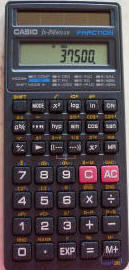STEP
INTO THE GED
Introduction to the Scientific Calculator
IN THIS UNIT:
Reading Passage and Practice:
Introduction to the Scientific Calculator
Math: Basic math
using the scientific calculator
Vocabulary:
Calculator usage terms
Writing: Phrases, writing an outline
Project: Graphs
Game:
Word Detective
______________________________________

SUPPORT ACTIVITIES IN
READING | WRITING |
MATH |
PROJECT |
FUN
A calculator is a very useful tool. It makes math calculations fast and easy. Most calculators work in similar ways. Here, we will be using the Casio fx-260 solar because it is the one that people use for some parts of the GED.
In this unit, we will study basic calculations: addition, subtraction, multiplication, and division.
First, you need to find the following keys on your calculator.
|
On |
Turns on the calculator |
|
C |
Clears (erases) only the last entry (some calculations may be left) |
|
AC |
Clears all calculations |
|
+ |
Adds numbers |
|
− |
Subtracts numbers |
|
× |
Multiplies numbers |
|
÷ |
Divides numbers |
|
= |
Gives results or answers |
|
► |
Works like a backspace on your keyboard, one number at a time |
To turn the Casiofx-260 solar off, place it back in its case. The lack of light will turn it off. This saves the battery for a later use.
In order to do problems with the calculator, you need to press the keys exactly as they are shown in the formulas. For example, if you see a problem like this
123 + .4 = 123.4
you would
press 1, press 2, press 3, press +, press ., press 4, press =,
the result pops up.
Look at the three keys: C, AC and ► Sometimes, the difference in these keys is not very clear. Try these three problems to see what they do differently. Check your answer after you do each one.
1. 857 + 204 C + 100 =
2. 857 + 204 AC + 100 =
3. 857 + 204 ► =
There is one last thing you should know about the Casio. It follows the rule of order of operations. If a calculation has several steps, those steps must be in order. The calculator will do the multiplication and division calculations first. Then it will do the addition and subtraction calculations. That is the order in which all math calculations should be done.
For example, what is the answer to the equation (number problem) below?
7 + 3 X 3 = ?
The answer is 7 + 9 = 16 (First multiply 3 times 3, then add seven.) You'll work more with this idea in your math practice.
The calculator will do all kinds of problems. You don't need a calculator for simple calculations. For difficult problems, it is much easier or faster to use a calculator. A working calculator never makes mistakes unless it is broken. So you might use it to check your answers sometimes.
Brain Gym
Guess Your Way
Match the numbers on the right to the statements on the left.
| a. There are ____ ridges in a quarter. | 1. 140,000 | |
| b. There are over ____ quills on a porcupine. | 2. 20 | |
| c. There are ____ feathers on a bald eagle | 3. 118 | |
| d. Blonde people have the most hair per inch, with an average of ____ hairs a head. | 4. 7,000 | |
| e. There are ____ dimples on a golf ball. | 5. 30,000 | |
| f. There are ____ ridges on a dime. | 6. 119 |
![]()
![]()